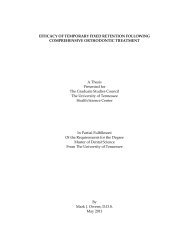BEVACIZUMAB EFFECT ON TOPOTECAN PHARMACOKINETICS ...
BEVACIZUMAB EFFECT ON TOPOTECAN PHARMACOKINETICS ...
BEVACIZUMAB EFFECT ON TOPOTECAN PHARMACOKINETICS ...
You also want an ePaper? Increase the reach of your titles
YUMPU automatically turns print PDFs into web optimized ePapers that Google loves.
over-pruned microvessel [146, 147]. In contrast, the increased intratumoral TMZ<br />
concentration and penetration is significantly correlated to the VNI of the tumor [51,<br />
148]. This increased intratumoral TMZ concentration is likely due to the proper tumor<br />
vasculature normalization. Thus defining the tumor vasculature normalization window<br />
and favorable effects of anti-angiogenic agents on the penetration of cytotoxic drugs into<br />
solid tumors is difficult, but crucial for the success of the combination of the<br />
anti-angiogenic agents and cytotoxic drugs regimen.<br />
1.5.2 The effects of BEV on cytotoxic drugs disposition in solid tumors<br />
No publications have estimated the effect of BEV on cytotoxic drug penetration in<br />
solid tumors for clinical patients, but several papers [152, 153] demonstrate that there is<br />
no pharmacokinetic interaction between BEV and cytotoxic drugs in the plasma of<br />
patients with solid tumors. Thus in this section, we will only discuss the effects of BEV<br />
on cytotoxic drugs disposition in solid tumors evaluated in preclinical studies.<br />
In preclinical studies, Yanagisawa [49] demonstrated that the co-administration of<br />
BEV significantly increased the intratumoral paclitaxel concentration in both murine<br />
MX-1 human breast cancer and A547 human lung cancer xenograft models. Recently,<br />
We also evidenced that the intratumoral penetration of TPT was enhanced as much as<br />
81% when given 1 to 3 days after BEV, compared with when both drugs were given<br />
concomitantly, or 7 days apart in neuroblastoma xenografts [154]. In consistent with this<br />
observation, tumor vasculature normalization was observed within 7 days after BEV<br />
administration and antitumor activity was also significantly enhanced when administering<br />
TPT 3 days after BEV compared to monotherapy or concomitant administration of the<br />
two drugs. The increased intratumoral penetration of TPT was closely associated with<br />
normalization of the tumor vasculature. Furthermore, Davidoff (St. Jude Children’s<br />
Research Hospital, Memphis, TN) found that the tumor vasculature normalization<br />
window occurred between 2 to 5 days after BEV administration in the murine Rh30<br />
rhabdomyosarcoma xenograft, and the treatment with ionizing radiation 2 or 5 days after<br />
BEV resulted in the greatest antitumor activity [155]. In order to further investigate<br />
whether there is a similar effect of BEV on TPT penetration in this Rh30 xenograft and<br />
whether an optional schedule of the BEV and TPT will lead to enhanced tumor<br />
inhibition, we proposed the current project to answer above questions and ultimately<br />
benefit children with rhabdomyosarcoma cancer by providing a better chemotherapy<br />
regimen. As discussed above, ARMS has a relatively low OS rate and is resistant to TPT<br />
treatment. If we can identify the optimal schedule of BEV and TPT, and enhance the<br />
intratumoral penetration and efficacy of TPT by using preclinical model, we may be able<br />
to design proper clinical trials to confirm the preclinical findings and improve the OS rate<br />
for children with ARMS.<br />
16
















